Global Leadership and Management: Challenges and Strategies
VerifiedAdded on 2022/09/26
|6
|1331
|25
Essay
AI Summary
This essay delves into the relationship between leadership and management, exploring their distinct yet interconnected roles in driving enterprise success, particularly within a global context. It defines global leadership, emphasizing the need for a global mindset and skills such as critical thinking and flexibility. The essay contrasts leadership and management, highlighting their complementary contributions to organizational strategy. It identifies key challenges faced by global leaders and managers, including conflict management, cultural diversity, and the need to motivate a diverse workforce. The essay discusses the importance of developing effective leadership and management skills, including innovative thinking and strategic planning. It emphasizes the role of a global mindset in navigating these challenges and achieving enterprise goals, concluding that both leadership and management are crucial for overall enterprise success in an increasingly interconnected world. The essay draws on various sources to support its arguments and provides insights into the complexities of global leadership and management in the modern business environment.
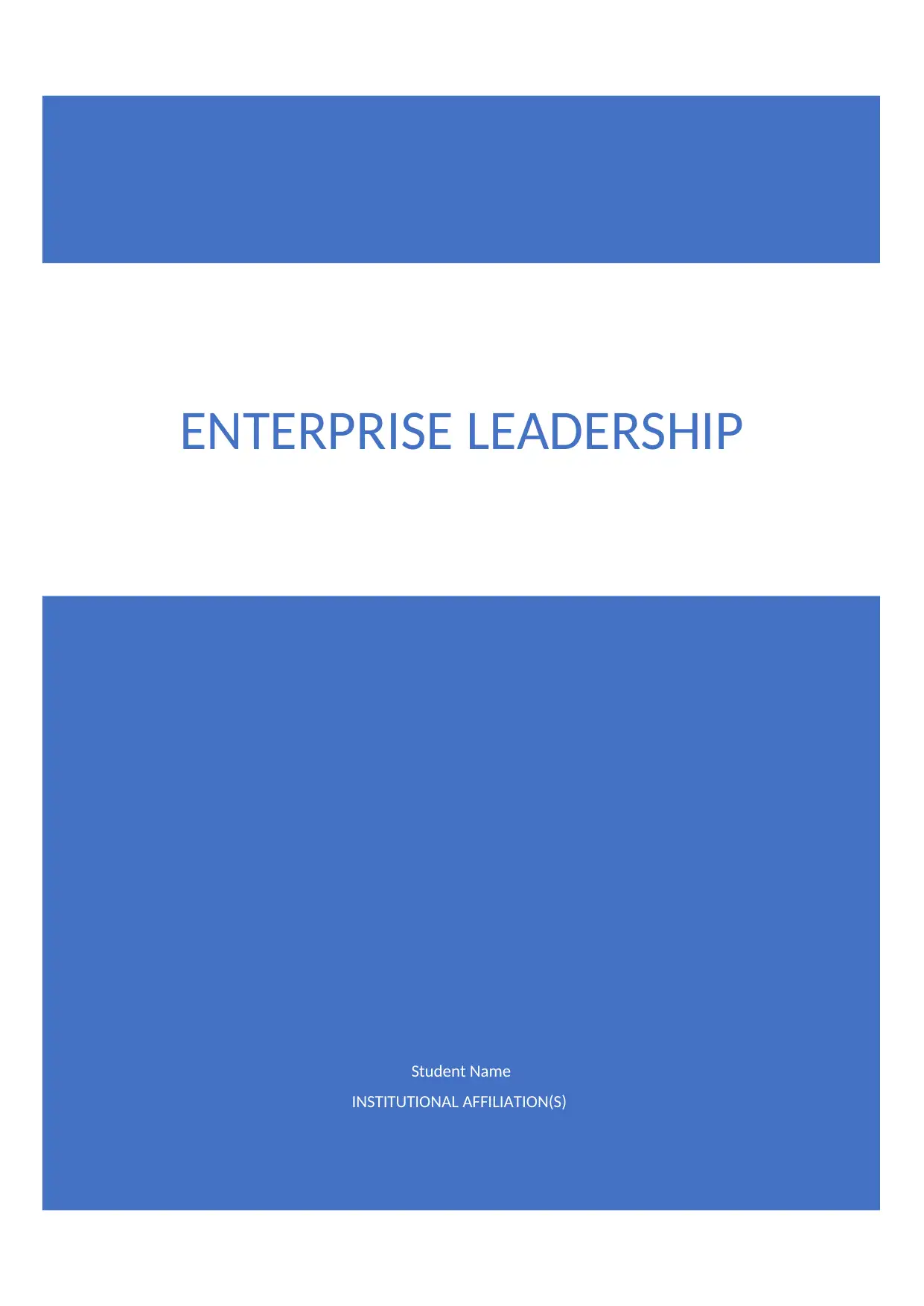
Student Name
INSTITUTIONAL AFFILIATION(S)
ENTERPRISE LEADERSHIP
INSTITUTIONAL AFFILIATION(S)
ENTERPRISE LEADERSHIP
Paraphrase This Document
Need a fresh take? Get an instant paraphrase of this document with our AI Paraphraser
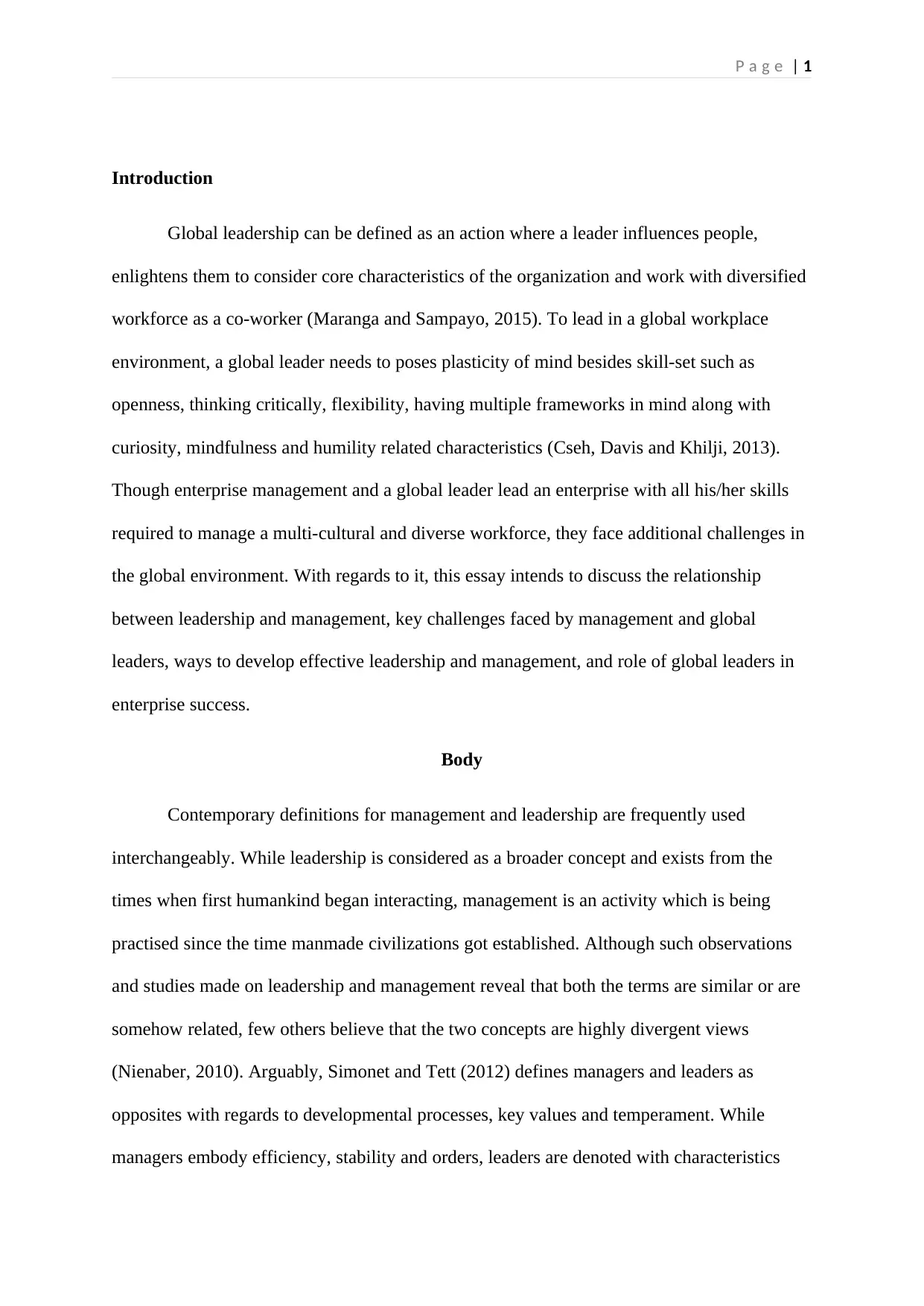
P a g e | 1
Introduction
Global leadership can be defined as an action where a leader influences people,
enlightens them to consider core characteristics of the organization and work with diversified
workforce as a co-worker (Maranga and Sampayo, 2015). To lead in a global workplace
environment, a global leader needs to poses plasticity of mind besides skill-set such as
openness, thinking critically, flexibility, having multiple frameworks in mind along with
curiosity, mindfulness and humility related characteristics (Cseh, Davis and Khilji, 2013).
Though enterprise management and a global leader lead an enterprise with all his/her skills
required to manage a multi-cultural and diverse workforce, they face additional challenges in
the global environment. With regards to it, this essay intends to discuss the relationship
between leadership and management, key challenges faced by management and global
leaders, ways to develop effective leadership and management, and role of global leaders in
enterprise success.
Body
Contemporary definitions for management and leadership are frequently used
interchangeably. While leadership is considered as a broader concept and exists from the
times when first humankind began interacting, management is an activity which is being
practised since the time manmade civilizations got established. Although such observations
and studies made on leadership and management reveal that both the terms are similar or are
somehow related, few others believe that the two concepts are highly divergent views
(Nienaber, 2010). Arguably, Simonet and Tett (2012) defines managers and leaders as
opposites with regards to developmental processes, key values and temperament. While
managers embody efficiency, stability and orders, leaders are denoted with characteristics
Introduction
Global leadership can be defined as an action where a leader influences people,
enlightens them to consider core characteristics of the organization and work with diversified
workforce as a co-worker (Maranga and Sampayo, 2015). To lead in a global workplace
environment, a global leader needs to poses plasticity of mind besides skill-set such as
openness, thinking critically, flexibility, having multiple frameworks in mind along with
curiosity, mindfulness and humility related characteristics (Cseh, Davis and Khilji, 2013).
Though enterprise management and a global leader lead an enterprise with all his/her skills
required to manage a multi-cultural and diverse workforce, they face additional challenges in
the global environment. With regards to it, this essay intends to discuss the relationship
between leadership and management, key challenges faced by management and global
leaders, ways to develop effective leadership and management, and role of global leaders in
enterprise success.
Body
Contemporary definitions for management and leadership are frequently used
interchangeably. While leadership is considered as a broader concept and exists from the
times when first humankind began interacting, management is an activity which is being
practised since the time manmade civilizations got established. Although such observations
and studies made on leadership and management reveal that both the terms are similar or are
somehow related, few others believe that the two concepts are highly divergent views
(Nienaber, 2010). Arguably, Simonet and Tett (2012) defines managers and leaders as
opposites with regards to developmental processes, key values and temperament. While
managers embody efficiency, stability and orders, leaders are denoted with characteristics
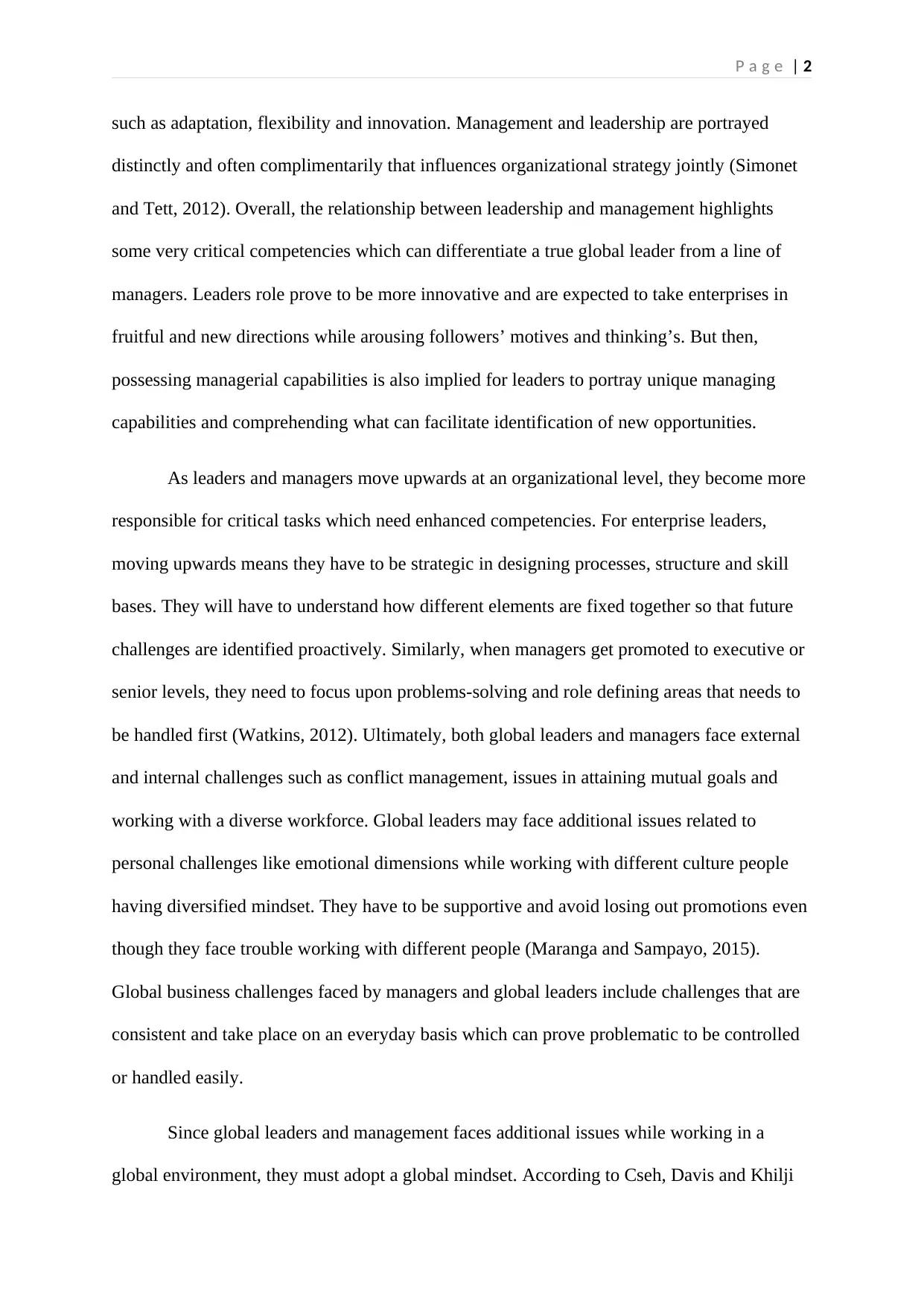
P a g e | 2
such as adaptation, flexibility and innovation. Management and leadership are portrayed
distinctly and often complimentarily that influences organizational strategy jointly (Simonet
and Tett, 2012). Overall, the relationship between leadership and management highlights
some very critical competencies which can differentiate a true global leader from a line of
managers. Leaders role prove to be more innovative and are expected to take enterprises in
fruitful and new directions while arousing followers’ motives and thinking’s. But then,
possessing managerial capabilities is also implied for leaders to portray unique managing
capabilities and comprehending what can facilitate identification of new opportunities.
As leaders and managers move upwards at an organizational level, they become more
responsible for critical tasks which need enhanced competencies. For enterprise leaders,
moving upwards means they have to be strategic in designing processes, structure and skill
bases. They will have to understand how different elements are fixed together so that future
challenges are identified proactively. Similarly, when managers get promoted to executive or
senior levels, they need to focus upon problems-solving and role defining areas that needs to
be handled first (Watkins, 2012). Ultimately, both global leaders and managers face external
and internal challenges such as conflict management, issues in attaining mutual goals and
working with a diverse workforce. Global leaders may face additional issues related to
personal challenges like emotional dimensions while working with different culture people
having diversified mindset. They have to be supportive and avoid losing out promotions even
though they face trouble working with different people (Maranga and Sampayo, 2015).
Global business challenges faced by managers and global leaders include challenges that are
consistent and take place on an everyday basis which can prove problematic to be controlled
or handled easily.
Since global leaders and management faces additional issues while working in a
global environment, they must adopt a global mindset. According to Cseh, Davis and Khilji
such as adaptation, flexibility and innovation. Management and leadership are portrayed
distinctly and often complimentarily that influences organizational strategy jointly (Simonet
and Tett, 2012). Overall, the relationship between leadership and management highlights
some very critical competencies which can differentiate a true global leader from a line of
managers. Leaders role prove to be more innovative and are expected to take enterprises in
fruitful and new directions while arousing followers’ motives and thinking’s. But then,
possessing managerial capabilities is also implied for leaders to portray unique managing
capabilities and comprehending what can facilitate identification of new opportunities.
As leaders and managers move upwards at an organizational level, they become more
responsible for critical tasks which need enhanced competencies. For enterprise leaders,
moving upwards means they have to be strategic in designing processes, structure and skill
bases. They will have to understand how different elements are fixed together so that future
challenges are identified proactively. Similarly, when managers get promoted to executive or
senior levels, they need to focus upon problems-solving and role defining areas that needs to
be handled first (Watkins, 2012). Ultimately, both global leaders and managers face external
and internal challenges such as conflict management, issues in attaining mutual goals and
working with a diverse workforce. Global leaders may face additional issues related to
personal challenges like emotional dimensions while working with different culture people
having diversified mindset. They have to be supportive and avoid losing out promotions even
though they face trouble working with different people (Maranga and Sampayo, 2015).
Global business challenges faced by managers and global leaders include challenges that are
consistent and take place on an everyday basis which can prove problematic to be controlled
or handled easily.
Since global leaders and management faces additional issues while working in a
global environment, they must adopt a global mindset. According to Cseh, Davis and Khilji
⊘ This is a preview!⊘
Do you want full access?
Subscribe today to unlock all pages.

Trusted by 1+ million students worldwide
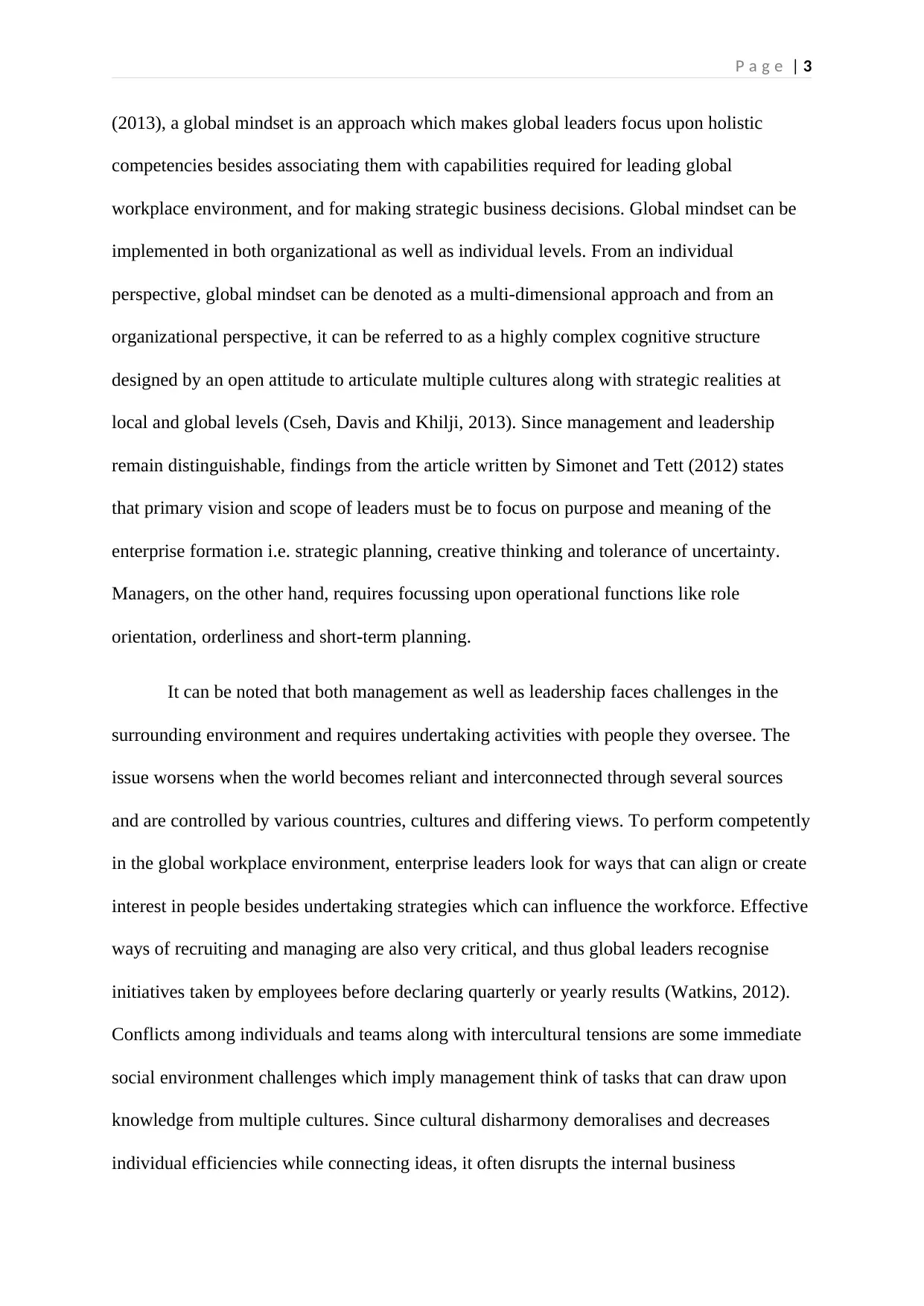
P a g e | 3
(2013), a global mindset is an approach which makes global leaders focus upon holistic
competencies besides associating them with capabilities required for leading global
workplace environment, and for making strategic business decisions. Global mindset can be
implemented in both organizational as well as individual levels. From an individual
perspective, global mindset can be denoted as a multi-dimensional approach and from an
organizational perspective, it can be referred to as a highly complex cognitive structure
designed by an open attitude to articulate multiple cultures along with strategic realities at
local and global levels (Cseh, Davis and Khilji, 2013). Since management and leadership
remain distinguishable, findings from the article written by Simonet and Tett (2012) states
that primary vision and scope of leaders must be to focus on purpose and meaning of the
enterprise formation i.e. strategic planning, creative thinking and tolerance of uncertainty.
Managers, on the other hand, requires focussing upon operational functions like role
orientation, orderliness and short-term planning.
It can be noted that both management as well as leadership faces challenges in the
surrounding environment and requires undertaking activities with people they oversee. The
issue worsens when the world becomes reliant and interconnected through several sources
and are controlled by various countries, cultures and differing views. To perform competently
in the global workplace environment, enterprise leaders look for ways that can align or create
interest in people besides undertaking strategies which can influence the workforce. Effective
ways of recruiting and managing are also very critical, and thus global leaders recognise
initiatives taken by employees before declaring quarterly or yearly results (Watkins, 2012).
Conflicts among individuals and teams along with intercultural tensions are some immediate
social environment challenges which imply management think of tasks that can draw upon
knowledge from multiple cultures. Since cultural disharmony demoralises and decreases
individual efficiencies while connecting ideas, it often disrupts the internal business
(2013), a global mindset is an approach which makes global leaders focus upon holistic
competencies besides associating them with capabilities required for leading global
workplace environment, and for making strategic business decisions. Global mindset can be
implemented in both organizational as well as individual levels. From an individual
perspective, global mindset can be denoted as a multi-dimensional approach and from an
organizational perspective, it can be referred to as a highly complex cognitive structure
designed by an open attitude to articulate multiple cultures along with strategic realities at
local and global levels (Cseh, Davis and Khilji, 2013). Since management and leadership
remain distinguishable, findings from the article written by Simonet and Tett (2012) states
that primary vision and scope of leaders must be to focus on purpose and meaning of the
enterprise formation i.e. strategic planning, creative thinking and tolerance of uncertainty.
Managers, on the other hand, requires focussing upon operational functions like role
orientation, orderliness and short-term planning.
It can be noted that both management as well as leadership faces challenges in the
surrounding environment and requires undertaking activities with people they oversee. The
issue worsens when the world becomes reliant and interconnected through several sources
and are controlled by various countries, cultures and differing views. To perform competently
in the global workplace environment, enterprise leaders look for ways that can align or create
interest in people besides undertaking strategies which can influence the workforce. Effective
ways of recruiting and managing are also very critical, and thus global leaders recognise
initiatives taken by employees before declaring quarterly or yearly results (Watkins, 2012).
Conflicts among individuals and teams along with intercultural tensions are some immediate
social environment challenges which imply management think of tasks that can draw upon
knowledge from multiple cultures. Since cultural disharmony demoralises and decreases
individual efficiencies while connecting ideas, it often disrupts the internal business
Paraphrase This Document
Need a fresh take? Get an instant paraphrase of this document with our AI Paraphraser
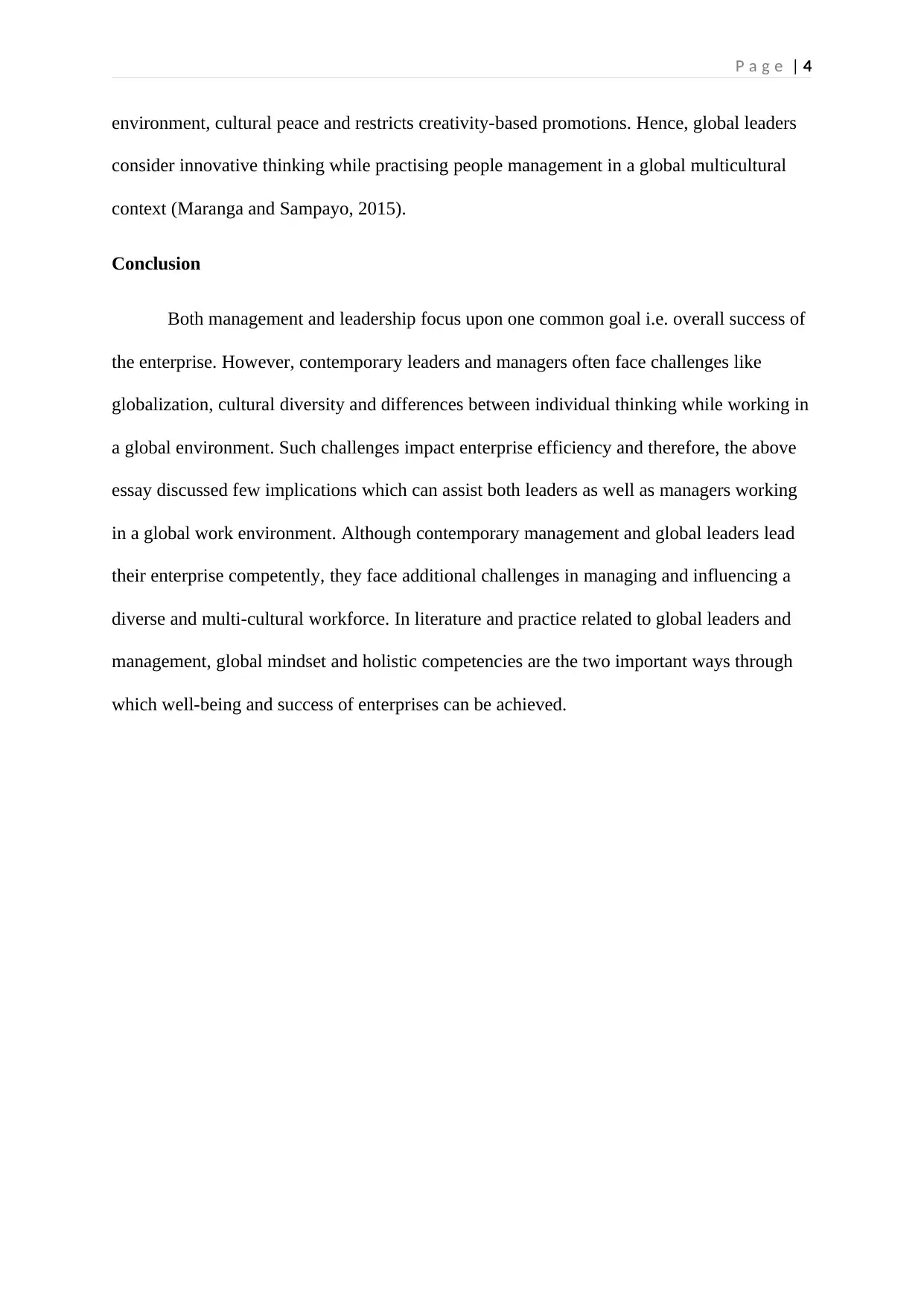
P a g e | 4
environment, cultural peace and restricts creativity-based promotions. Hence, global leaders
consider innovative thinking while practising people management in a global multicultural
context (Maranga and Sampayo, 2015).
Conclusion
Both management and leadership focus upon one common goal i.e. overall success of
the enterprise. However, contemporary leaders and managers often face challenges like
globalization, cultural diversity and differences between individual thinking while working in
a global environment. Such challenges impact enterprise efficiency and therefore, the above
essay discussed few implications which can assist both leaders as well as managers working
in a global work environment. Although contemporary management and global leaders lead
their enterprise competently, they face additional challenges in managing and influencing a
diverse and multi-cultural workforce. In literature and practice related to global leaders and
management, global mindset and holistic competencies are the two important ways through
which well-being and success of enterprises can be achieved.
environment, cultural peace and restricts creativity-based promotions. Hence, global leaders
consider innovative thinking while practising people management in a global multicultural
context (Maranga and Sampayo, 2015).
Conclusion
Both management and leadership focus upon one common goal i.e. overall success of
the enterprise. However, contemporary leaders and managers often face challenges like
globalization, cultural diversity and differences between individual thinking while working in
a global environment. Such challenges impact enterprise efficiency and therefore, the above
essay discussed few implications which can assist both leaders as well as managers working
in a global work environment. Although contemporary management and global leaders lead
their enterprise competently, they face additional challenges in managing and influencing a
diverse and multi-cultural workforce. In literature and practice related to global leaders and
management, global mindset and holistic competencies are the two important ways through
which well-being and success of enterprises can be achieved.
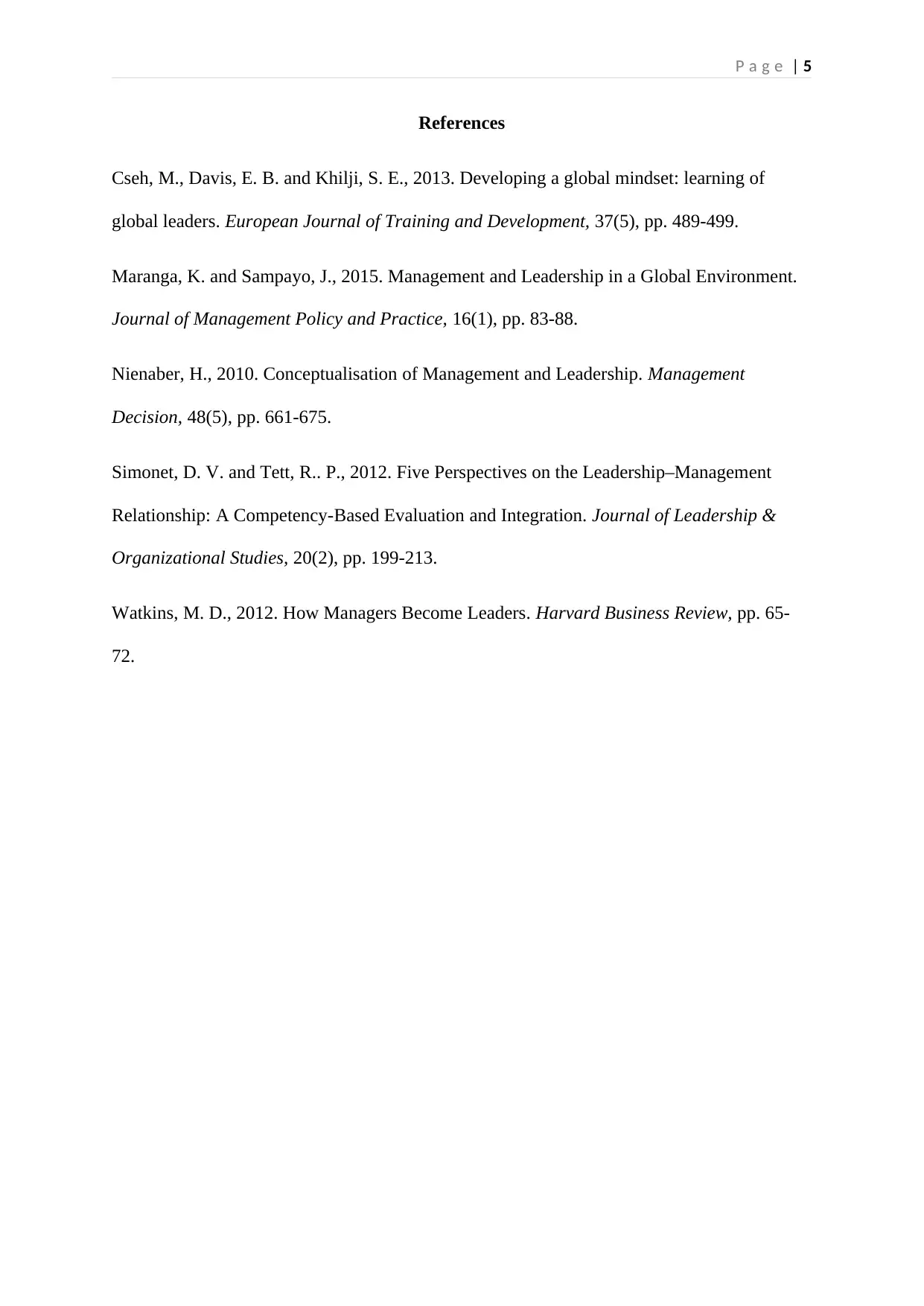
P a g e | 5
References
Cseh, M., Davis, E. B. and Khilji, S. E., 2013. Developing a global mindset: learning of
global leaders. European Journal of Training and Development, 37(5), pp. 489-499.
Maranga, K. and Sampayo, J., 2015. Management and Leadership in a Global Environment.
Journal of Management Policy and Practice, 16(1), pp. 83-88.
Nienaber, H., 2010. Conceptualisation of Management and Leadership. Management
Decision, 48(5), pp. 661-675.
Simonet, D. V. and Tett, R.. P., 2012. Five Perspectives on the Leadership–Management
Relationship: A Competency-Based Evaluation and Integration. Journal of Leadership &
Organizational Studies, 20(2), pp. 199-213.
Watkins, M. D., 2012. How Managers Become Leaders. Harvard Business Review, pp. 65-
72.
References
Cseh, M., Davis, E. B. and Khilji, S. E., 2013. Developing a global mindset: learning of
global leaders. European Journal of Training and Development, 37(5), pp. 489-499.
Maranga, K. and Sampayo, J., 2015. Management and Leadership in a Global Environment.
Journal of Management Policy and Practice, 16(1), pp. 83-88.
Nienaber, H., 2010. Conceptualisation of Management and Leadership. Management
Decision, 48(5), pp. 661-675.
Simonet, D. V. and Tett, R.. P., 2012. Five Perspectives on the Leadership–Management
Relationship: A Competency-Based Evaluation and Integration. Journal of Leadership &
Organizational Studies, 20(2), pp. 199-213.
Watkins, M. D., 2012. How Managers Become Leaders. Harvard Business Review, pp. 65-
72.
⊘ This is a preview!⊘
Do you want full access?
Subscribe today to unlock all pages.

Trusted by 1+ million students worldwide
1 out of 6
Related Documents
Your All-in-One AI-Powered Toolkit for Academic Success.
+13062052269
info@desklib.com
Available 24*7 on WhatsApp / Email
![[object Object]](/_next/static/media/star-bottom.7253800d.svg)
Unlock your academic potential
Copyright © 2020–2025 A2Z Services. All Rights Reserved. Developed and managed by ZUCOL.





